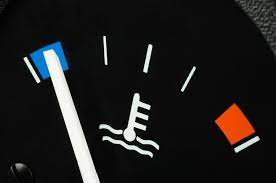If you check your car’s temperature gauge and it is below normal, you might be wondering why this is happening to your vehicle. Luckily for you, there are some simple reasons why your car’s temperature gauge is low. In this article, we will discuss the different reasons why your car may be running cool as well as what needs to be done to fix the issue.
Why Is My Car Temperature Gauge Low?
If you have noticed that your car’s temperature gauge is low, it’s important to know the reason behind it. There are many things that could cause a low reading on a temperature gauge including:
- A faulty sensor or thermostat
- A cooling system blockage
- Low engine coolant levels
A faulty thermostat
The first step to diagnosing and fixing the issue is understanding what the thermostat does. Thermostats are a little like the “brain” of your engine’s cooling system. They prevent your car from overheating by regulating the temperature of your engine’s coolant. When it’s cold, they tell your car to heat up faster, keeping you warm on those chilly mornings. However, when it’s hot, they keep things cool by allowing excess heat to escape through the radiator.
If you’re experiencing any of these symptoms, you might need a new thermostat.
- Your vehicle takes longer than normal to warm up
- Your engine continues to overheat even after you’ve changed both the radiator cap and coolant
- The temperature gauge in your car rises too high, or doesn’t go high enough
Leaky radiator hoses
A leaky radiator hose is the most common reason for a car’s temperature gauge to be low. The hoses are made of rubber and they can get brittle over time, so they either get a hole or they become loose and leak where they connect to the engine. Radiator hoses are usually located close to the front of the engine compartment, so if you see pools of liquid under your car, it could be coolant.
Low coolant levels
Coolant is a mixture of water and antifreeze which helps cool down the engine when it is running. A low coolant level, however, will cause the engine to overheat. The coolant level should be between the minimum and maximum marks. If it is low, top up with a mixture of half water and half antifreeze.
To check the coolant level:
Turn off your car’s engine, and wait for it to fully stop (and make sure it’s cooled down).
First, check the coolant level in the overflow reservoir located near the radiator cap. You can add some more if needed by opening where indicated on the reservoir and pouring in a 50/50 mix of distilled water and antifreeze (you will find this mixture at any auto parts store).
Now take a look at your temperature gauge. If you’ve topped up your car’s coolant but you’re still seeing warning lights or an overheating indication on your gauge, something else may be amiss—in that case we suggest taking your car to an expert—but as long as things are reading properly after topping off your vehicle with both clean oil and clean coolant, there shouldn’t be any reason to worry!
Bad water pump
A water pump that isn’t working properly can be a problem for your car because it is an important part of the cooling system. It is relatively inexpensive to fix, but if you ignore it, then you could end up with a much more expensive repair bill. While this part can sometimes wear out or break, it is most likely just clogged and needs to be serviced.
Faulty radiator cap
One possible cause of low temperature is a faulty radiator cap. A car’s radiator cap keeps the coolant sealed in the radiator, preventing it from escaping. The cap also regulates pressure in the cooling system. If the radiator cap is faulty, then coolant will leak out of the system, causing your temperature gauge to read low or normal.
If your car temperature gauge is always low, get it checked. It can prevent overheating and engine damage.
It’s important to get a vehicle checked out if the temperature gauge spends most of its time on “cold” instead of in the normal range (this is usually indicated by a blue or green area). If you’re seeing this, it probably means that your car isn’t reaching its operating temperature. If a car doesn’t get up to the correct temperature, it can’t burn away the condensation in your oil and fuel. This leads to premature engine wear, as well as deposits building up on your spark plugs. To top it all off, if your car isn’t getting hot enough, you’re losing out on fuel economy as well.
If you notice any of these problems or changes while driving your vehicle, make sure to have our qualified mechanics look at it right away. It may not be anything serious–a faulty thermostat could be to blame–but there are times when low temperature can point toward bigger issues. Make sure you have them diagnosed so they don’t become more costly later on down the road!


